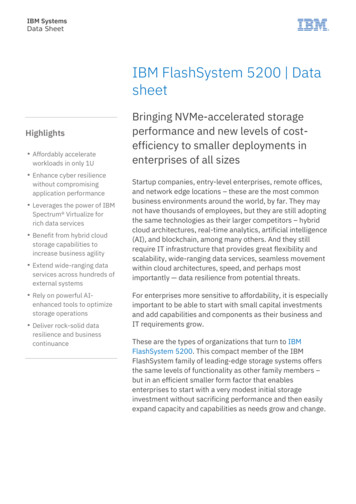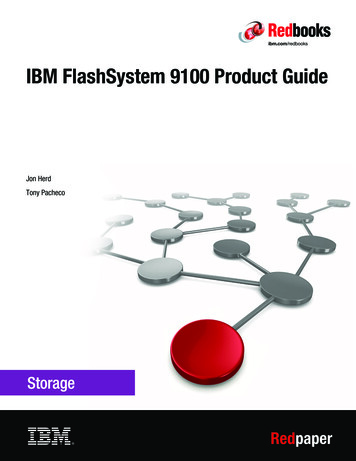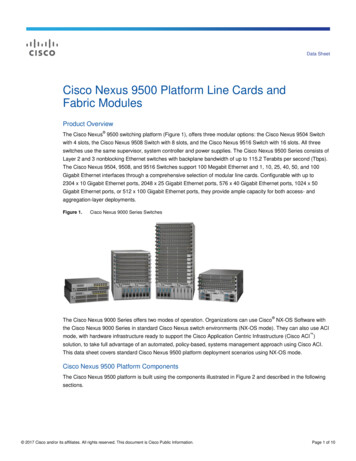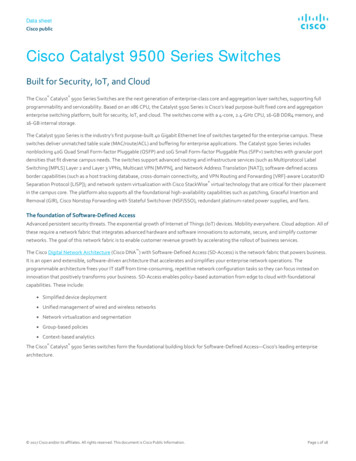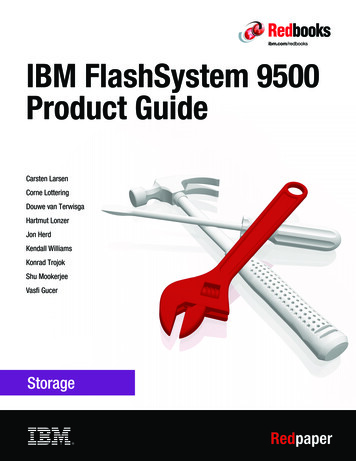
Transcription
Front coverIBM FlashSystem 9500Product GuideCarsten LarsenCorne LotteringDouwe van TerwisgaHartmut LonzerJon HerdKendall WilliamsKonrad TrojokShu MookerjeeVasfi GucerRedpaper
IBM FlashSystem 9500 Product GuideThis IBM Redpaper Product Guide describes the IBM FlashSystem 9500 solution, whichis a next-generation IBM FlashSystem control enclosure. It combines the performance offlash and a Non-Volatile Memory Express (NVMe)-optimized architecture with the reliabilityand innovation of IBM FlashCore technology and the rich feature set and high availability(HA) of IBM Spectrum Virtualize.Often, applications exist that are foundational to the operations and success of an enterprise.These applications might function as prime revenue generators, guide or control importanttasks, or provide crucial business intelligence, among many other jobs. Whatever theirpurpose, they are mission critical to the organization. They demand the highest levels ofperformance, functionality, security, and availability. They also must be protected against themodern scourge, cyberattacks.To support such mission-critical applications, enterprises of all types and sizes turn to the IBMFlashSystem 9500.IBM FlashSystem 9500 provides a rich set of software-defined storage (SDS) features thatare delivered by IBM Spectrum Virtualize, including the following examples: Data reduction and deduplication Dynamic tiering Thin-provisioning Snapshots Cloning Replication and data copy services Cyber resilience Transparent Cloud Tiering IBM HyperSwap including 3-site replication for HA Scale-out and scale-up configurations that further enhance capacity and throughput forbetter availabilityWith the release of IBM Spectrum Virtualize V8.5, extra functions and features are available,including support for new third-generation IBM FlashCore Modules NVMe-type drives withinthe control enclosure, and 100 Gbps Ethernet adapters that provide NVMe Remote DirectMemory Access (RDMA) options. New software features include GUI enhancements andsecurity enhancements, including multifactor authentication (MFA) and single sign-on (SSO),and Fibre Channel (FC) portsets. Copyright IBM Corp. 2022. All rights reserved.ibm.com/redbooks3
Flash for less than the cost of diskIntegral to the IBM FlashSystem 9500 solution is the IBM FlashCore technology. The recentevolution of this technology saw enhanced compression technology that enables up to116 TB to be stored in a single drive.The IBM FlashSystem 9500 system with IBM FlashCore Modules features includes built-inhardware data compression, and this data reduction is “always on”. This compression isimplemented in hardware by using field-programmable gate arrays (FPGAs) within eachmodule and uses a modified dynamic GZIP algorithm. With this approach, the solution candeliver the level of performance that you expect without compression, with the added benefitof better use of the physical storage.IBM FlashCore Modules implement hardware-based compression without any performancepenalty. Performance scales linearly with the number of instances.In addition, IBM FlashSystem 9500 control enclosure supports data reduction poolcompression and deduplication that can increase the effective capacity of your flash memoryup to 5x, which decreases the cost of storing data up to 80%. Data reduction pools supportactive data, unlike other data reduction solutions.The IBM FlashSystem 9500 control enclosure offers several features for data reduction poolcompression workloads. These features include two 24 Intel core processors with up to1.5 TB of memory per node, and a built-in compression accelerator for hardware-assistedcompression. In addition, the IBM FlashSystem 9500 system with IBM FlashCore ModulesNVMe-type drives applies compression to any data that is not compressed.Agile integrationThe IBM FlashSystem 9500 system features the following agile characteristics: Fully integrated system management. Application-aware data services. Advanced Encryption Standard (AES), data at rest encryption with all NVMe type drives,and IBM FlashCore Modules drives with FIPS 140-3. In-line hardware compression with IBM FlashCore Modules. Tiering or mirroring to existing or Public Cloud storage. Mixed workload consolidation. Nondisruptive data migrations. Concurrent code load.By accelerating physical and virtual applications, the IBM FlashSystem 9500 system can helporganizations reduce costs, increase revenue, and improve customer satisfaction for all typesof applications, including the following categories: 4TransactionalEnterprise resource planning (ERP) and supply chain managementBig data and analyticsServer and desktop virtualizationCloud nativeHybrid and multicloudIBM FlashSystem 9500 Product Guide
AI-empoweredThe IBM FlashSystem 9500 system includes the following AI characteristics: AI-based data placement for optimal data center performance and zero-downtime datamigration. IBM Storage Insights: AI-empowered predictive analytics, storage resource management,and a support platform that is delivered over the cloud.Multicloud enabledIBM Spectrum Virtualize on-premises and IBM Spectrum Virtualize for Public Cloud togethersupport mirroring between on-premises and cloud data centers or between cloud datacenters. These functions can be used to perform the following tasks: Migrate data between on-premises and public cloud data centers or between public clouddata centers. Enjoy consistent data management between on-premises storage and thepublic cloud. Implement Disaster Recovery (DR) strategies between on-premises and public cloud datacenters. Enable cloud-based DevOps with easy replication of data from on-premises sources. Improve cyber resilience with copies on Amazon Web Services (AWS) by using air gapsnapshots to S3 and IBM Safeguarded Copy on Microsoft Azure.Customers can create hybrid multicloud solutions for their traditional block data andworkloads by using built-in IP replication capabilities.Deploy IBM Spectrum Virtualize for Public Cloud on AWS directly from AWS Marketplacethrough a predefined Cloud Formation Template that automatically and securely installs thesoftware, and deploys a HA two-node cluster on selected EC2 instances. Any Amazon EBSblock storage can be attached.On Azure, deploy directly from the Azure Apps Marketplace through predefined AzureResource Manager templates that automatically and securely install the software, and deployan HA two-node cluster on selected Azure VMs. Attach shared Azure Managed Disksolid-state drive (SSDs) to the cluster for HA.On IBM Cloud , automated installation scripts assist deployment of the software onbare-metal servers. IBM Performance or Endurance block storage is supported behind thecluster. This setup enables clients to create clustered configurations, such as on-premises,while bringing the optimization and virtualization capabilities of IBM Spectrum Virtualize topublic cloud infrastructures.IBM Spectrum Virtualize on-premises and IBM Spectrum Virtualize for Public Cloud togetherenable a hybrid multicloud deployment with a single data management layer betweenon-premises systems and the cloud across heterogeneous storage pools that might exist inthe data center. IBM Spectrum Virtualize provides the following functions: Storage pooling and automated allocation with thin provisioning Easy Tier automated tiering Deduplication and compression to reduce cloud storage costs FlashCopy and remote mirror for local snapshots and remote replication5
IBM Safeguarded Copy for Cyber Resiliency Support for virtualized and containerized server environments including:––––––VMwareMicrosoft Hyper-VIBM PowerVM Red Hat OpenShiftCRI-OKubernetesFor more information about IBM FlashSystem systems and hybrid multicloud, see IBMFlashSystems and Hybrid Multicloud.Rock-solid data resilienceThe IBM FlashSystem 9500 provides advanced capabilities that can help maximize dataprotection, security, and HA to significantly reduce the risk of disruption and financial lossesthat can occur because of user errors, malicious destruction, or ransomware attacks.FlashSystem 9500 delivers the capability to enable this level of protection while alsodelivering high performance for applications.With Safeguarded Copy, the IBM FlashSystem 9500 adds a line of defense againstcyberthreats by protecting your valued data from cyberattacks with immutable and isolatedcopies that are hidden, nonaddressable, and cannot be altered. If an attack occurs, thesecopies can be quickly restored to support recovery. Customized to your specific applicationmix, Cyber Vault builds on IBM Safeguarded Copy to help reduce cyberattack recovery times.A Cyber Vault solution runs continuously and monitors snapshots as they are createdautomatically by Safeguarded Copy. By using standard database tools and automationsoftware, Cyber Vault checks Safeguarded Copy snapshots for corruption. If Cyber Vault findssuch changes, it is an immediate sign that an attack might be occurring.When preparing a response, knowing the last snapshots with no evidence of an attackspeeds determining which snapshot to use. Because Safeguarded Copy snapshots are onthe same FlashSystem storage as operational data, recovery is fast by using the samesnapshot technology. With these advantages, Cyber Vault is designed to help reducecyberattack recovery time from days to just hours.Advanced data servicesThe IBM FlashSystem 9500 system provides the following advanced data services: 6Business continuity with replication services across up to three sitesData protection with IBM FlashCopy servicesHA with IBM HyperSwapHigher storage efficiency with thin provisioningData reduction pools that provide compression with deduplicationData-at-rest AES-XTS 256 encryptionIBM Easy TierExternal virtualizationData migrationIP quorum supportN Port ID virtualization (NPIV) supportIBM FlashSystem 9500 Product Guide
VMware vSphere Virtual Volume (VVOL) support and space-efficient copiesTransparent Cloud TieringData and cyber resilience with IBM Safeguarded CopyContainer support with the IBM block storage CSI driverCapacity and performance scaling through clusteringIBM FlashSystem 9500 enclosures overviewThe IBM FlashSystem 9500 system features the following types of enclosures: A control enclosure manages your storage systems, communicates with the host, andmanages interfaces. In addition, it can house up to 48 NVMe-capable flash drives. Thesedrives can be industry-standard NVMe types or the exclusive IBM FlashCore Module(FCM) NVMe type and up to 12 optional Storage Class Memory (SCM) type drives. An expansion enclosure increases the available capacity of an IBM FlashSystem 9500cluster. It communicates with the control enclosure through a dual pair of 12 Gbpsserial-attached SCSI (SAS) connections. This enclosure can house many of the flash(SSDs) SAS type drives, depending on which model of enclosure is ordered.Figure 1 shows the IBM FlashSystem 9500 control enclosure front view where you can seethe 48 NVMe drives in two rows of 24 drives.Figure 1 IBM FlashSystem 9500 control enclosure front viewEach control enclosure can have multiple attached expansion enclosures, which expand theavailable capacity of the entire system. The IBM FlashSystem 9500 solution supports up totwo control enclosures and up to two chains of SAS expansion enclosures per controlenclosure.The IBM FlashSystem 9500 control enclosure supports up to 48 NVMe-capable flash drivesin a 4U high form factor and consists of the following machine types and models: 4666-AH8: IBM FlashSystem 9500 control enclosure 4666-UH8: IBM FlashSystem 9500 control enclosure utility model7
Note: The 4666 UH8 model is an IBM FlashSystem 9500 solution with a 1-year warranty,optional Storage Expert Care service offerings, and is a 4666 offered in the Storage UtilityOffering space. This model is physically and functionally identical to the IBM FlashSystem4666 AH8 model, except for target configurations and variable capacity billing.The variable capacity billing uses IBM Spectrum control or IBM Storage Insights to monitorthe system usage, which allows allocated storage usage above a base subscription rate tobe billed per terabyte per month. Allocated storage is identified as storage that is allocatedto a specific host (and unusable to other hosts), whether data is written. Forthin-provisioning, the data that is written is considered used. For thick-provisioning, thetotal allocated volume space is considered used.The IBM FlashSystem 9500 control enclosures include the following features: Two node canisters, each with two 24-core processors and options for up to 1.5 GBmemory to deliver a system total of 3 TB memory. Up to 12 (six per canister) I/O adapter cages to add PCIe adapter features:–––––32 Gb FC connectivity10/25 Gb Ethernet connectivity100 Gb Ethernet connectivity12 Gb SAS ports for expansion enclosure attachment (cage 2 only)Dedicated Compression QAT adapter card (unmarked cage, slot 3) Support for up to 48 NVMe flash drive options. Hot-swappable batteries, boot drives and AC power supplies. 4U, 19-inch rack mount enclosure.Note: At the time of this writing, the IBM FlashSystem 9500 control enclosure supportsonly 12 of the 38.4 TB FCM drives. This restriction is to be lifted in a future release of IBMSpectrum Virtualize software.For more information about configuration and limit restrictions, see this IBM Support webpage.Expansion enclosuresThe IBM FlashSystem 9000 expansion enclosures consist of the following machine types andmodels: 4666 model AFF small form factor (SFF) 4666 model A9F large form factor (LFF)The new SAS-based SFF and LFF expansion enclosures support flash SSDs as MDisks in astorage pool, which can be used for IBM Easy Tier. The following expansion enclosuremodels are available: IBM FlashSystem 9000 SFF Expansion Enclosure Model AFF offers drive options with upto 24 2.5-inch SSD flash drives. Up to 72 drives in three AFF SAS expansion enclosuresare supported per IBM FlashSystem 9500 control enclosure. The AFF expansionenclosure is 2U high.8IBM FlashSystem 9500 Product Guide
IBM FlashSystem 9000 LFF Expansion Enclosure Model A9F offers drive options with upto 92 3.5-inch (and 2.5-inch drives in carriers) SSD flash drives. Up to 92 drives in oneA9F SAS expansion enclosure are supported per IBM FlashSystem 9500 controlenclosure.SAS chain limitationsWhen attaching expansion enclosures to the control enclosure, you are not limited by the typeof the enclosure. The only limitation for each of the two SAS chains is its chain weight. Eachtype of enclosure has its own chain weight: IBM FlashSystem 9000 Expansion Enclosure Model AFF has a chain weight of 1. IBM FlashSystem 9000 Expansion Enclosure Model A9F has a chain weight of 2.5. IBM FlashSystem 9500 has a maximum SAS chain weight is 3.For example, with the IBM FlashSystem 9500, you can have three IBM FlashSystem 9000Expansion Enclosure Model AFF or one IBM FlashSystem 9000 Expansion Enclosure ModelA9F expansions (3 x 1 or 1 x 2.5) per SAS chain.Note: A 5U expansion enclosure cannot be mixed with 2U expansion enclosures on thesame chain.For more information about configuration and limit restrictions, see this IBM Support webpage.IBM FlashSystem 9500R rackThe FlashSystem 9500R rack offering is a preassembled, installed, and configured by IBMproduct that contains the following components: A pair of clustered IBM FlashSystem 9500 Control Enclosures Models AH8, which can bespecified by ordering a IBM FlashSystem 9502R. Two 32G Gb FC switches for dedicated FC clustered network.Other components, such as IBM FlashSystem 9000 Expansion Enclosure Models AFF andA9F, can be added to the rack after delivery to meet the growing needs of the business.Figure 2 shows the legend that is used to denote the component placement and mandatorygaps for the figures that show the configurations.Figure 2 9500R component placement legend9
Figure 3 shows the layout of the components in the IBM FlashSystem 9500R rack enclosureand the positions that are assigned for the option expansion enclosures.Figure 3 IBM FlashSystem 9500R rack enclosureFor more information about the IBM FlashSystem 9500R offering, see this data sheet.Placing your IBM FlashSystem 9500 in your infrastructureVarious possible use cases are available for the IBM FlashSystem 9500, all of which canaddress many technical or business requirements. In addition, the FlashSystem 9500 can beused to simplify the overall storage architecture.The FlashSystem 9500 can be used in the following scenarios: First tier storage repository for production data. Primary or target system for data replication or DR. HA storage within a HyperSwap configuration (where two FlashSystem 9500s are in asynchronous replication relationship). Externally virtualizing IBM or non-IBM storage by using IBM Spectrum Virtualize, whichextends advanced functions (such as data reduction, encryption, and replication) to thosestorage subsystems.10IBM FlashSystem 9500 Product Guide
Data migration from IBM or non-IBM storage with IBM Spectrum Virtualize. Hybrid cloud storage by:– Enabling communication between an on-premises deployment of IBM SpectrumVirtualize and IBM Spectrum Virtualize for Public Cloud– Deploying the Container Storage Interface (CSI) driver for Red Hat OpenShiftContainer Platform to provide persistent storage for on-premises or cloud-basedcontainerized applications– Using Transparent Cloud Tiering (TCT) to convert data into an object store for back upto certain available cloud instances Support and interoperability within the IBM Spectrum Storage Software Suite, including:– IBM Spectrum Scale where the FlashSystem 9500 can be used as the back-endstorage repository for metadata, primary data, or in initial microprogram load (IML)processing– IBM Spectrum Protect and IBM Spectrum Protect Plus where the FlashSystem 9500can be used as cache or data repository IBM Copy Data Management where the FlashSystem 9500 can be used as cache or acopy services target.Figure 4 shows an IBM FlashSystem 9500 that is fully deployed in a hybrid multicloudenvironment where it is also externally virtualizing various on-premises storage subsystems.Figure 4 Fully deployed IBM FlashSystem 9500 sample scenarioThe IBM FlashSystem 9500 can support multiple Open System hosts and interoperability withall of the software from the IBM Spectrum Suite of products.11
In this scenario, the IBM FlashSystems 9500 provides the following benefits: Investment protection of established storage by using IBM Spectrum Virtualize to migratefrom older storage subsystems and externally virtualize existing heterogeneous storage. A hybrid multicloud architecture by connecting to IBM Spectrum Virtualize for PublicCloud, which is available in AWS, Azure and IBM Virtual Public Cloud. Data protection by extending HA and DR to heterogeneous storage that is externallyvirtualized. Support for containerized workloads by interfacing with Red Hat OpenShift andKubernetes for on-premises and off-premises infrastructures. Ease of management and seamless integration with the IBM Storage Insights and all theproducts in the IBM Spectrum Software Suite.Did you know?The IBM FlashSystem 9500 runs on IBM Spectrum Virtualize V8.5, which provides: Control enclosure support for SSDs, including up to 48 industry 2.5-inch SFF standardNVMe drives and IBM FlashCore Modules and up to 12 SCM drives.The following NVMe drives are supported:– 2.5-inch SFF 4.8 TB, 9.6 TB, 19.2 TB, or 38.4 TB IBM FlashCore Module NVMe drives– 1.92 TB, 3.84 TB, 7.68 TB,15.36 TB, or 30.72 TB industry-standard drives– A mixture of both– Storage Class Memory drives of 1.6 TB Autonomic tiering through Easy Tier, which enables workload data to be placed on themost suitable storage media (various classes of NVMe for the control enclosure and HDDsand commodity SSDs for the expansion enclosures and externally virtualized storage). Hardware-based data reduction and encryption from the IBM FlashCore Modules withnegligible impact on system performance. Scale-out capacity options with the 12 Gb SAS-attached model 12G, 24G, and 92Gexpansion enclosures. Software-based AES-256 data-at-rest encryption and key management through IBMSecurity Key Lifecycle Manager or USB key encryption. Up to four Security Key LifecycleManager key servers are supported. Remote support assistance, which enables IBM support personnel to access the systemto complete troubleshooting tasks. Multiple data-protection solutions, such as FlashCopy (point-in-time-copy), Metro Mirror(synchronous replication), and Global Mirror (asynchronous replication). Cyberresiliency with Safeguarded Copy, which provides rapid ransomware recovery byusing immutable, untouchable snapshots that are based on FlashCopy technology. Multiple management modes by using a graphical user interface (GUI) or a Linux-basedcommand-line interface (CLI). Performance throttling that allows control of used resources when the system isprocessing host I/O, advanced functions, or copy services. TCT, which enables a FlashCopy volume that can be backed up to an S3 object store,such as AWS or IBM Cloud.12IBM FlashSystem 9500 Product Guide
Support for 32 Gb FC and 10/25 GBE or 100 GbE iSCSI and NVMe RDMA connectivity.The ability to intermix these port options also is supported. Simplified connectivity by using portsets, which enable host connectivity ports to begrouped for more effective zoning and management. Easy access and compatibility with IBM Storage Insights, which offers advancedperformance monitoring for one or more IBM FlashSystem 9500s. Extra access security through MFA.In addition to the base warranty, the IBM FlashSystem 9500 offers IBM Storage Expert Carewith three levels of support options.Current release functionsThis section describes several new functions and features that are available in the currentIBM FlashSystem 9500 release.New in IBM FlashSystem 9500 Software V8.5.0The following functions are included in IBM FlashSystem 9500 Software V8.5.0: 3-Site Data Replication for HyperSwap3-Site Data Replication for HyperSwap supports the following use cases:– Disaster scenarios– Site maintenance– Link failure cases Security updates:– A new set of options that allows a security administrator to create policies forpasswords, account lockout, and session timeout.– Create a single system-wide policy that applies to all local accounts (session timeoutsalso apply to remote accounts).– Configurable CLI timeout.– HTTP proxy server for Cloud Call Home and IBM Spectrum Virtualize Family StorageReplication Adapter (SRA) log upload.– NVME drive security updates (new events and sense data to better identify and resolveNVMe drive encryption errors) and secure data deletion. UI modernization updates:––––Modernized syslog servers windowNew host dialogNew Add Storage experienceModernized remote copy experience (2-site and 3-site) DRAID-1:– 2-member drives per array (0 rebuild area)– 3 - 16 member drives per array (1 rebuild area)– System recommendation is to create DRAID-1 in arrays up to six drives13
Data reduction child pools:– User can create child pools in data reduction parent pools– Data reduction child pools are created without a quota and can use entire parentcapacity Data reduction pool (DRP) updates:– Redirect-on-write for DRP snapshots adds a redirect-on-write (RoW) alternative to theexisting copy-on-write (CoW) capabilities– Comprestimator always on– RAID Reconstruct Read (3R) by using RAID capabilities; DRP asks for a specific datablock reconstruction when detecting a potential corruption Miscellaneous:– Updates to the maximum configuration limits. For more information, see this IBMSupport web page.– 8.5.0 mirrored VDisks fast format enhancements.– 8.5.0 FC-NVMe enhancements.– 8.5.0 improved handling of memory errors.– SCM restrictions lifted. For more information, see “Storage Class Memory” on page 16.– 8.5.0 DNS support enhancements. Support for IBM FlashSystem 9500 enclosures with new larger NVMe drives. Support of 48 NVMe drives per DRAID array (DRAID-6). Secure remote access provides a secure connection for remote support with auditlogging. Management GUI enhancements. Ownership groupsAn ownership group defines a subset of users and objects within the system. You cancreate ownership groups to further restrict access to specific resources that are defined inthe ownership group. Priority flow controlPriority flow control (PFC) is an Ethernet protocol that supports the ability to select thepriority of different types of traffic within the network. Support for expanding distributed arrays (DRAID). Support for pool-level volume protectionVolume protection prevents active volumes or host mappings from being deletedinadvertently if the system detects recent I/O activity. Support for SNMP protocol version 3 enhanced security features. Support for enhanced auditing features for syslog servers. Enhanced password security.The user must change the default password to a different password on first login or systemsetup. Improvements to the terms and definitions that relate to capacity were updated. Support for the new SCM technology with implementation by using new drives from Inteland Samsung, which can enchain workload throughput, with or without the use of EasyTier.14IBM FlashSystem 9500 Product Guide
Three-site replicationThree-site replication provides enhanced disaster tolerance for IBM Spectrum Virtualizesystems, which allows coordination of data between three disparate sites for failover andfailback.At the time of this writing, three-site replication requires the submission of a requestthrough the SCORE system to help manage and ensure that the requirements andconfiguration details are met. Secure Drive Erase, which is the ability to completely erase any customer data from aNVMe, SAS SSD, or HDD before it is removed from the control and expansion enclosure.HighlightsIBM Spectrum Virtualize 8.5 delivers support for IBM FlashSystem 9500 machine type 4666models.This release provides all of the advanced software functions of IBM Spectrum Virtualizesoftware to FlashSystem 9500. It adds NVMe Remote Direct Memory Access (RDMA)support and MFA, and enables the use of FCMs and 100 Gb Ethernet.IBM FlashCore technologyAt the heart of the IBM FlashSystem 9500 system is IBM FlashCore technology (if the IBMFlashCore Module NVMe type drives are ordered), which consists of the followingkey elements: Hardware-accelerated architecture that is engineered for flash, with a hardware-only datapath. The IBM FlashSystem data compression and decompression algorithm is a modifieddynamic GZIP algorithm. Because it is implemented completely in hardware, no processorintervention is required. IBM FlashCore Modules, which are designed for low latency, density, and reliability. IBM Advanced Flash Management, which improves flash endurance over standardimplementations without sacrificing latency.Figure 5 on page 16 shows IBM FlashCore technology.15
Figure 5 IBM FlashCore technologyFor more information about IBM FlashCore technology, see IBM Documentation.Storage Class MemorySCM is an industry-wide buzz word for nonvolatile memory devices that perform faster( 10 µs) than traditional NAND (short for Not And) SSDs (100 µs), but slower than dynamicrandom access memory (DRAM) (100 ns).The technology pricing sits between DRAM and traditional NAND. The price is significantlymore expensive than traditional NAND drives.At the time of this writing, the following vendors are most prevalent in the marketplace: Intel (3D Xpoint memory technology in Optane drives) Samsung (zNAND memory technology in zSSDs)The IBM FlashSystem 9500 system supports the new low-latency, high-speed SCM drives inany of the slots of the control enclosure. The control enclosure can contain up to 12 SCMdrives.Note: SCM and other NVM Express (NVMe) drive types can be installed in any drive slot.However, the highest capacity drives must be installed in the lowest available drive slots.16IBM FlashSystem 9500 Product Guide
SCM and Easy TierBecause of their faster speed, SCM drives are placed in a new top tier of Easy Tier. This newtier is ranked higher than the existing tier0 flash that is used for NVMe NAND drives that aresupported today. The following Easy tier levels are available: Storage Class MemoryThe SCM tier exists when the pool contains drives that use persistent memorytechnologies that improve the endurance and speed of current flash storage devicetechnologies. Tier 0 flashTier 0 flash tier exists when the pool contains high performance flash drives. Tier 1 flashTier 1 flash tier exists when the pool contains tier 1 flash drives. Tier 1 flash drives typicallyoffer larger capacities, but slightly lower performance and write endurance characteristics. Enterprise tierEnterprise tier exists when the pool contains enterprise-class MDisks, which are diskdrives that are optimized for performance. Nearline tierNearline tier exists when the pool contains nearline-class MDisks, which are disk drivesthat are optimized for capacity.Hot data is placed in the SCM tier when Easy Tier is enabled. DRP and VG extent allocationwas tuned to use SCM drives, specially for metadata (directory volume lookups). This usecase is one of the main use cases for SCM drives with an IBM FlashSystem 9500 system.SCM and RAID configurationsSCM drives feature the following rules concerning RAID supported configurations: Distributed DRAID 1 with two drives (including distributed spare capacity) or more and isthe best practice recommendation and configuration. Distributed DRAID 6 with six drives (including distributed spare capacity) or more issupported. SCM drives have their own SCM technology type and drive class. SCM and Standard NVMe (or SAS) cannot intermix in the same array. Easy Tier tier
IBM FlashSystem 9500 provides a rich set of software-defined storage (SDS) features that are delivered by IBM Spectrum Virtualize, including the following examples: . IBM Storage Insights: AI-empowered predictive analytics, storage resource management, . software, and deploys a HA two-node cluster on selected EC2 instances. Any Amazon EBS

